"Theory
regarding the suspected quasi-bonded Na3Au-m configuration and
atomic configuration of Bose-Einstein condensates of transition elements"
Author: August Dunning: Trans-Metal Research Group,
Washington DC
Our suspicion is that during dissolution of NaOH
in the wet method causing a raise in pH by the Hydroxyl group, a ring of
Na is formed that provides the necessary electro-negative field that the
electro-positive Au-m BEC seeks. This may ultimately provide the actual
potential charge of the Au-M atom by back engineering it as the opposite
to the electro-negative charge inside the ring structure*
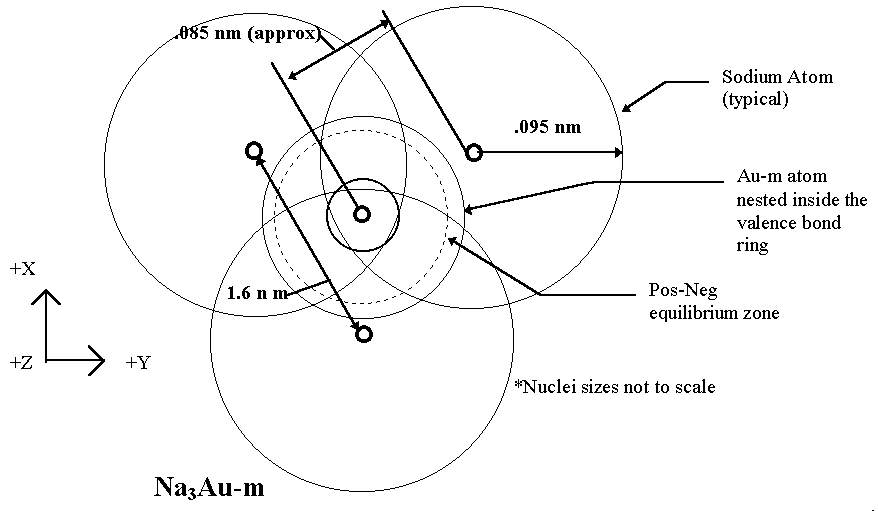
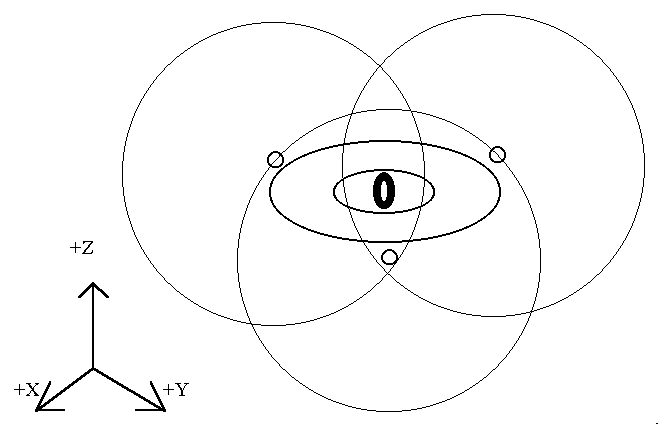
Possible co-planar orientation of the Au-m atom inside
the tri-sodium bond ring.
In this configuration, the monatomic atom rests inside
the second (2s) and third (2p) shell boundary of the sodium atom in its
bonded radius after valence bonding.
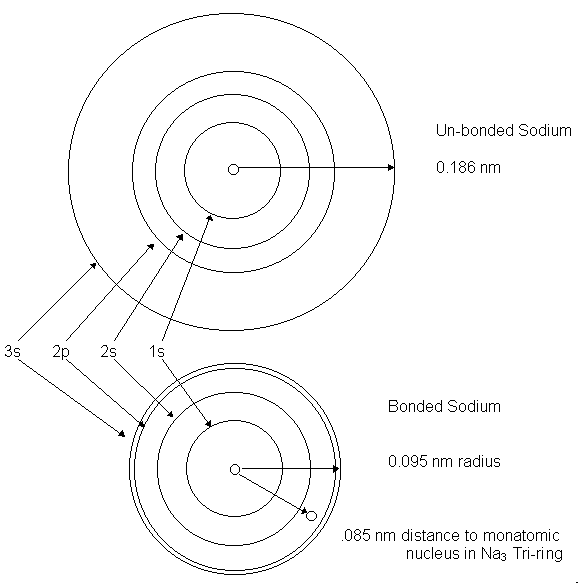
This arrangement places the electro-positive monatomic
inside the electro-negative field of three over-lapping electron orbitals
as seen in the illustrations above.
Note: that a period 6 atom is .262 nm in radius
before BEC. After BEC atoms of this period are mostly nuclei surrounded
by bosons, or light and the pseudo-physical boundary, that the electron
shells tend to represent, is no longer existent as the positive screen
field collapses the bosons into a disc in the plane of rotation
Some researchers have suspected a hex ring of sodium
as opposed to a tri-ring. Both tri-ring and hex-ring postulations are based
on a theory of variable quantal field potential in these elements. More
than likely both rings may play a role depending on the mass-size differences
seen in stable BEC's that started as odd or even numbered proton transition
elements.
-
The Na6 hex-ring might develop with the two
step to stable configuration of the double nuclei elements like 45-Rhodium,
77-Iridium, 79-Gold, 47-Silver, 27-Cobalt, etc., which forces merging of
same-nuclei to seek a more stable state.
-
The Na3 tri-ring may develop with the one
step to stable BEC seen in even numbered proton transition elements like
78-Platinum, 44-Ruthenium, 76-Osmium, 46-Palladium and perhaps all period
four transition elements.
It should be noted that this hexagonal ring theory may
not be possible as:
-
The available valence bonds do not create strong enough
ring bonds to form a strong, stable hexagonal ring
-
Hex rings usually require three alternating single bonds
and double bonds that sodium atoms can not offer.
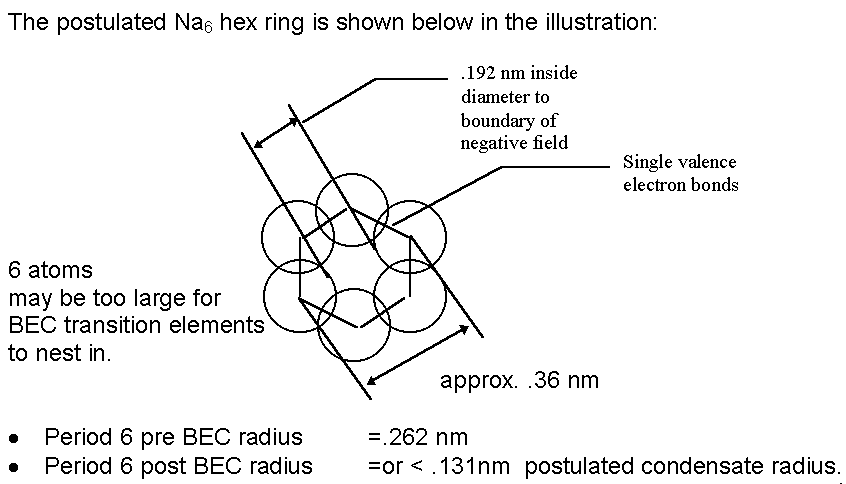
-
Radius may be much smaller and variable about the spinning
nucleus lobes of the deformed nuclei with a radial quantal potential field
occupying the former electron shell locations.
-
This field may be concentrated into a spinning disk
about the nucleus, perpendicular to the spin axis of the atom.
The actual potential quasi-bonding field may only be
.09nm in radius, similar to the radius of bonded sodium, and why it may
be a tri-sodium that 'nets' these elements. The Idea that monatomic BEC's
are at varying energy or quantal levels might be described as follows:
1. Upon destabilization and increased
separation of the incomplete outer shell nucleons around the completed
shells of a nucleus in a transition element, there is a subsequent cascade
effect toward positive screening field increase as the strong binding force
is over ridden by the electromagnetic forces, Cooper pairing and super
deformation with associated accelerated spin of the expanded nucleus. The
odd number proton monatomics may exhibit at least one basic sublevel after
BEC, before stabilization of the unpaired valence electron. This is an
unbalanced state that may flip from BEC back to metal bonds easily.
 This forms an unfinished lower energy m-state, with
one electron, as a positron, looking for a partner to Cooper pair with
creating a valence funnel.
This forms an unfinished lower energy m-state, with
one electron, as a positron, looking for a partner to Cooper pair with
creating a valence funnel.
2. Once another monatomic in the same
energy sub level is attracted by the electrostatic force, the valence funnels
collapse upon nuclei merging causing positron harmonization and finalized
Cooper pairing, thus forming a stable higher energy level configuration.
Chemical bonding is not available in this energy
state, only quantum coupling employing the Coulomb wave is available for
connecting BEC's. However, in the odd numbered proton transition elements,
this forms atomic quantal materials with unusually high mass values, but
of little or no weight, and can be made to loose all their gravitational
attraction or increase their weight by 300 percent by heating or cooling
respectively.

This is now a two dimensional quantum oscillator
vibrating near the ZPE as a result of Cooper pairing. The amplified electrostatic
forces are driven by the rotating quantal ring with a coulomb wave flowing
out along the plane of rotation. The former two unpaired electron fermions
are now balanced into a boson and superconduction begins with the associated
Meissner field generation.
Much has been made of the decrease in weight these
elements exhibit after BEC.
This might be explained by studies involving spinning
and stationary masses in a gravity field.
Michael Faraday 1831
-
Invention of the one piece Homopolar Generator exhibiting
inertial field phenomena
Podkletnov, E and R Nieminen, Physica C 203,
1992, pg 441-444 North-Holland
"A possibility of gravitational shielding by bulk
Yba2Cu307-x superconductor"
-
Gravity is attenuated above a spinning superconductor,
and the attenuation is related to the spin rate and the frequency of the
electromagnetic field levitating the object.
-
The shielding force depends on the rotational speed
of the disc and has a tendency to increase with the speed of rotation.
Hudson, 1990's
-
Monatomic elements will loose 4/9 of their gravitational
weight after BEC.
-
These elements can be made to weigh less than zero.
-
Beyond the zero weight point they visually disappear,
but are still measurable as a negative weight.
-
When cooled they gain weight.
DePalma, 1970's
-
Rotating objects falling in a gravitational field are
accelerated at a rate greater than 'G'.
-
Pendula utilizing bob weights which are rotating, swing
non sinusoidally with increased periods.
-
A precessing (spin node advancement) gyroscope has an
anomalous inertial mass, greater than it's gravitational mass.
-
Two gyroscopes on the same axle, spinning counter rotationally
at 7600 rpm with an additional 4 rps of the support cylinder, weighed 4
- 6 lbs. less than its 276 lb. starting weight while operating.
-
Rotating objects create an inertial field that distorts
(slows) time.
This phenomena may be a distortion of normally isotropic
space, the amount of distortion being represented by the reflected internally
constrained forces explicitly developed by the machine, or object in rotation.
These experiment results are not always along the
gravity gradient, indicating discrete field phenomena.
These experiments may exploit time as an aspect of
the ZPE.
In Monatomic stable BEC state of elements of the
transition series, this weight loss phenomena may be explained by understanding
that these elements are spinning and the former electrons are now rotating
in a plane perpendicular to the spin axis.
This may give them a relative vector force like any
flow of electrons through a wire as described as the 'left hand rule'.
In the left hand rule, a flow of electrons will generate
an electromagnetic field rotating clockwise to the direction of flow:

flow creates the field
This is remarkably like the rotational field phenomena
described by the above authors, and is evident in the structure of the
high spin monatomic elements as depicted below
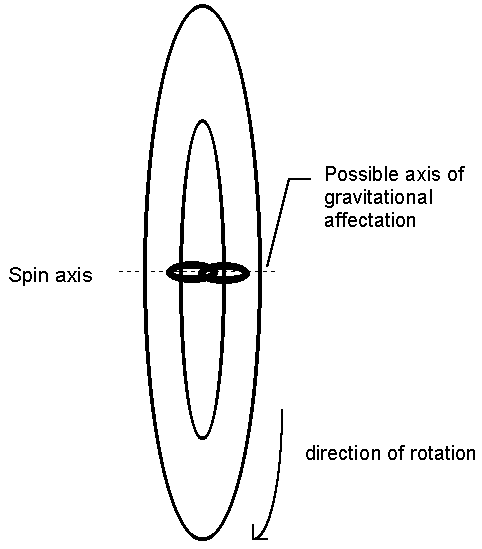
field creates the flow
In addition to the gravitational weight changes due
to rotating masses, the monatomic atom generates a Meissner field that
excludes gravity when energetic enough, and the effect on the atom caused
by Cooper pairing forces the atom to vibrate at, or very near, the residuum
vibration, 'k'.
A very curious relationship between ground state
and high spin state may be expressed in the conditions of the electrons
and nucleons as an inverse relationship.
-
Ground state atoms have stable nuclei and active electrons
-
high spin atoms have active nuclei and stable (former)
electrons as bosons
When an examination of the electron shells by energy
level and the amounts of electrons found in each is done, the distribution
of electrons might be shown to represent a boson toroidal ring that has
been lowered in energy level and expanded out amongst electron orbitals
as fermions of various energies. Transition elements after BEC may, because
of their atomic mass, enable them to produce a quantal disc with enough
potential to charge the nucleus with static electric energy thus generating
the coulomb wave used in resonance connectivity and deformation of the
nucleus as the 'charging' device of the high spin atoms.
Distribution of electrons per energy level
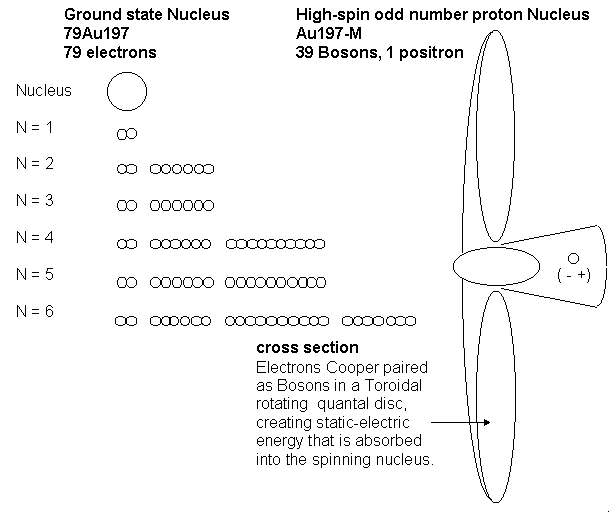
Another way to view this is by considering the electrons
as being either expanded or collapsed, and considering their energy levels
as particles or bosons.
-
In the particle state the positive screening potential
of the nucleus maintains distancing by demanding ordered pairs of time
forward and time reverse electrons as they fill the electron orbitals.
-
In the BEC process, ordered pairs in the electron shells
Cooper pair as the Positive screening potential expands causing time reverse
electrons, now in a positive field, to change into positrons, allowing
them to harmonize and Cooper pair with the time forward electrons and a
cascade of higher and higher spin, greater and greater positive field,
lower and lower strong binding force and higher and higher electrostatic
forces occurs.
I propose: that the electrostatic forces are
being driven by the friction between the nucleus and the boson quantal
field that is vibrating near the ZPE and taping the space-time fabric to
bring energy into an overunity condition that these m-state elements represent
and is pumping energy into the system.
My feeling is that once the electrons Cooper pair,
they all achieve a more or less identical energy state and tend to congregate
close to the nucleus with distance regulated by spin rate inertial field
changes. Double nuclei in the odd proton transition element BEC's have
a bigger Nucleus, but perhaps not a greater radius of quantal field potential
by the addition of the second set of Bosons. As massless as photons are,
they very well might be under different constraints than the remaining
nucleus particles and no longer follow predicted solid matter behavior.
Other thoughts to consider:
It has been demonstrated that a spinning disk can
attenuate gravity above the disk along the gravity gradient.
-
The velocity of the radial quantal disk theorized as
rotating around the spinning nucleus may play a part in the generating
of the Meissner field, a gravity excluding field, seen in these superconductors
and a possible mechanism in its generation.
-
This gravitational attenuation along the spin axis may
additionally be involved in the quasi-bonding of the sodium atom rings
described above.
-
The tuning of the atom to the Planck constant during
Cooper pairing forces the atom to vibrate near the Zero Point Energy, E0
= hf x ½, or the spectral energy density 'p' of the Zero-point fluctuation
as a function of that frequency, 'w', such that p(w) = kw3
-
These elements may be overunity systems.
It has been hypothesized that electrons lose energy,
but restore the loss by slipping into the zero point to tap the space-time
fabric. BEC's are mostly in the space-time fabric with their converted
electrons as bosons.
August Dunning
Transparent Metal Research Group










